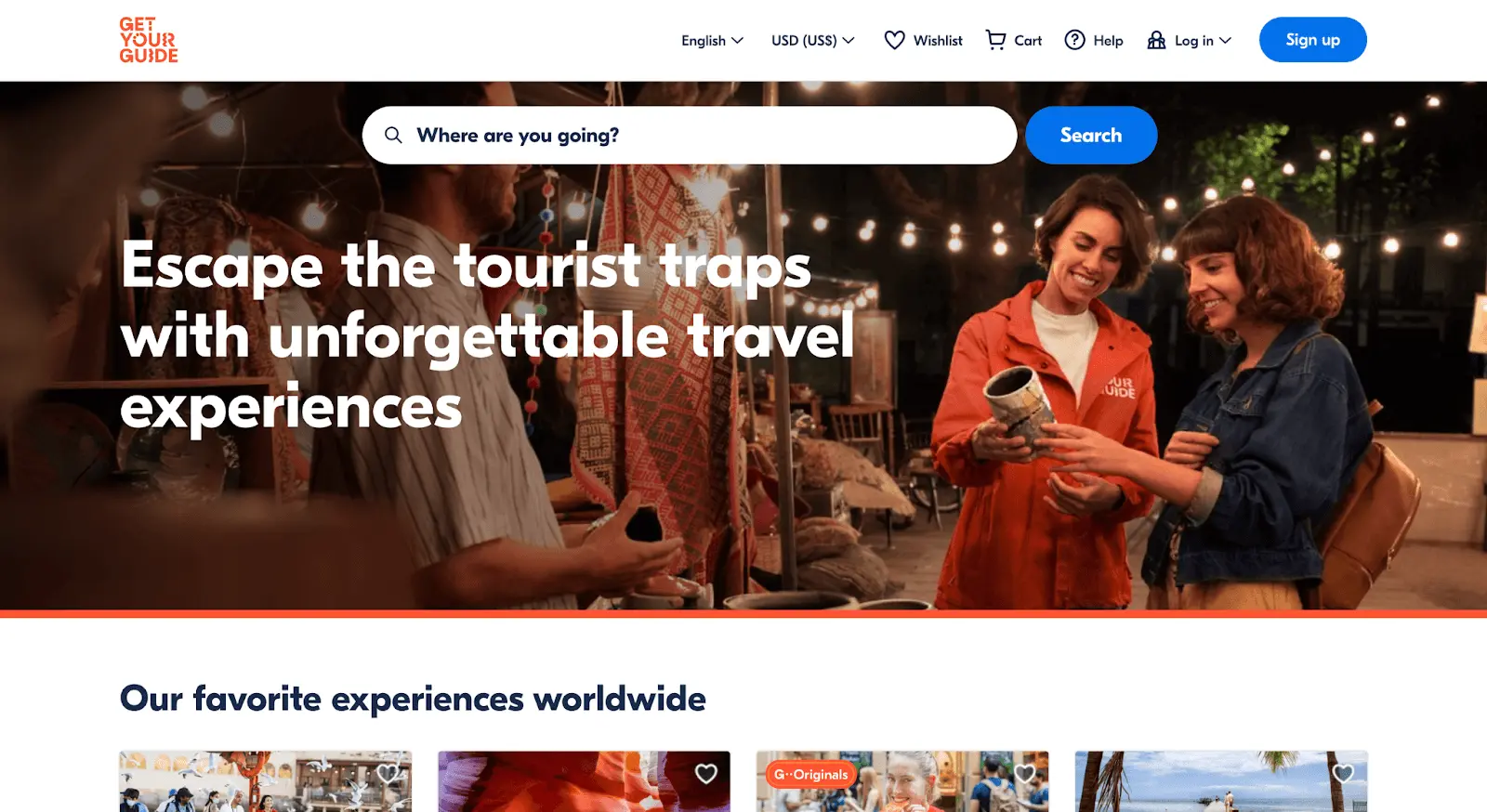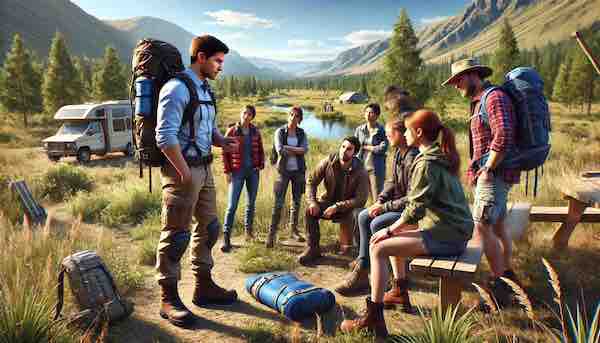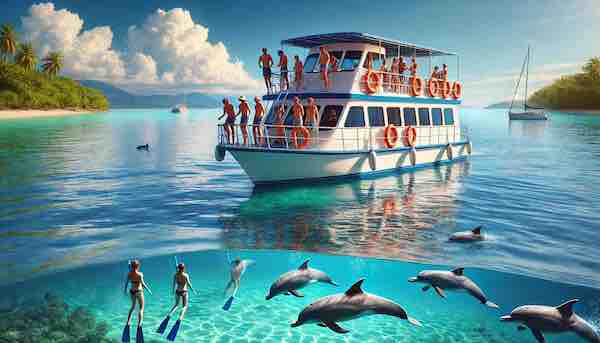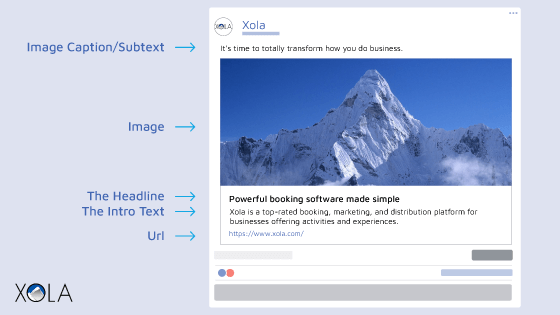
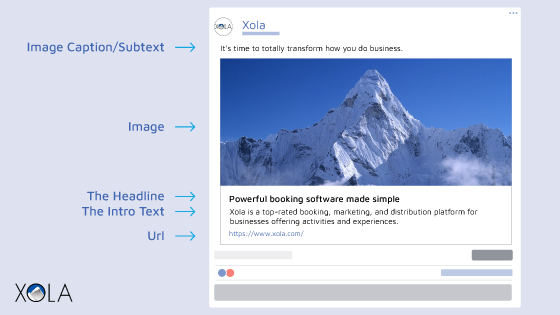
Did you know consumers are more likely to buy from a brand they follow on Facebook than Instagram, YouTube, Pinterest, Twitter, LinkedIn, Snapchat, and Reddit combined?
Of all the ways you can use social media to promote your company, Facebook ads are among the most effective. Facebook marketing is a great way for small and mid-sized tour operators and attractions to generate brand awareness and attract new customers.
Not sure how to create Facebook ads for tours? Let us break down the process for you in this post.
- Are Facebook Ads worth it?
- How do I set up my first Facebook ad campaign?
- How do you choose the best audience size and targeting for Facebook ads?
- What’s the difference between cold and retargeted Facebook ads?
- How to set up retargeting on Facebook?
- How to create targeted Facebook ads for tours and activities
- How much should I spend on Facebook ads?
- Facebook Ad campaign examples
Are Facebook Ads worth it?
Facebook allows businesses to create targeted ads that can reach travelers at the right point in their buying journey. No other marketing platform allows you to zero in on an audience with such precision.
Facebook also owns Instagram and Whatsapp, allowing you to cross-promote your ads on these platforms. Most people are finding travel inspiration on Facebook and Instagram. They’re saving photos of destinations they want to visit and the activities they want to do when they’re there.
This makes Facebook and Instagram ideal for tour operators because you can promote your tours and activities to an audience that’s actively looking for them.
How do I set up my first Facebook ad campaign?
If you’ve never set up a Facebook campaign, it’s time to create one. Here’s a step-by-step breakdown of how to launch your first Facebook ad.
Step 1: Set your goals
Before you create your Facebook ad, define exactly what you’re trying to achieve with it. Your goals might include:
- Increasing traffic to your website
- Generating new leads
- Increasing bookings through your website
- Getting more eyes on your Facebook content
- Boosting engagement for your Facebook Page
Your ad structure, audience, budget, and duration will all depend on your objective.
Step 2: Open your Facebook Ads Manager
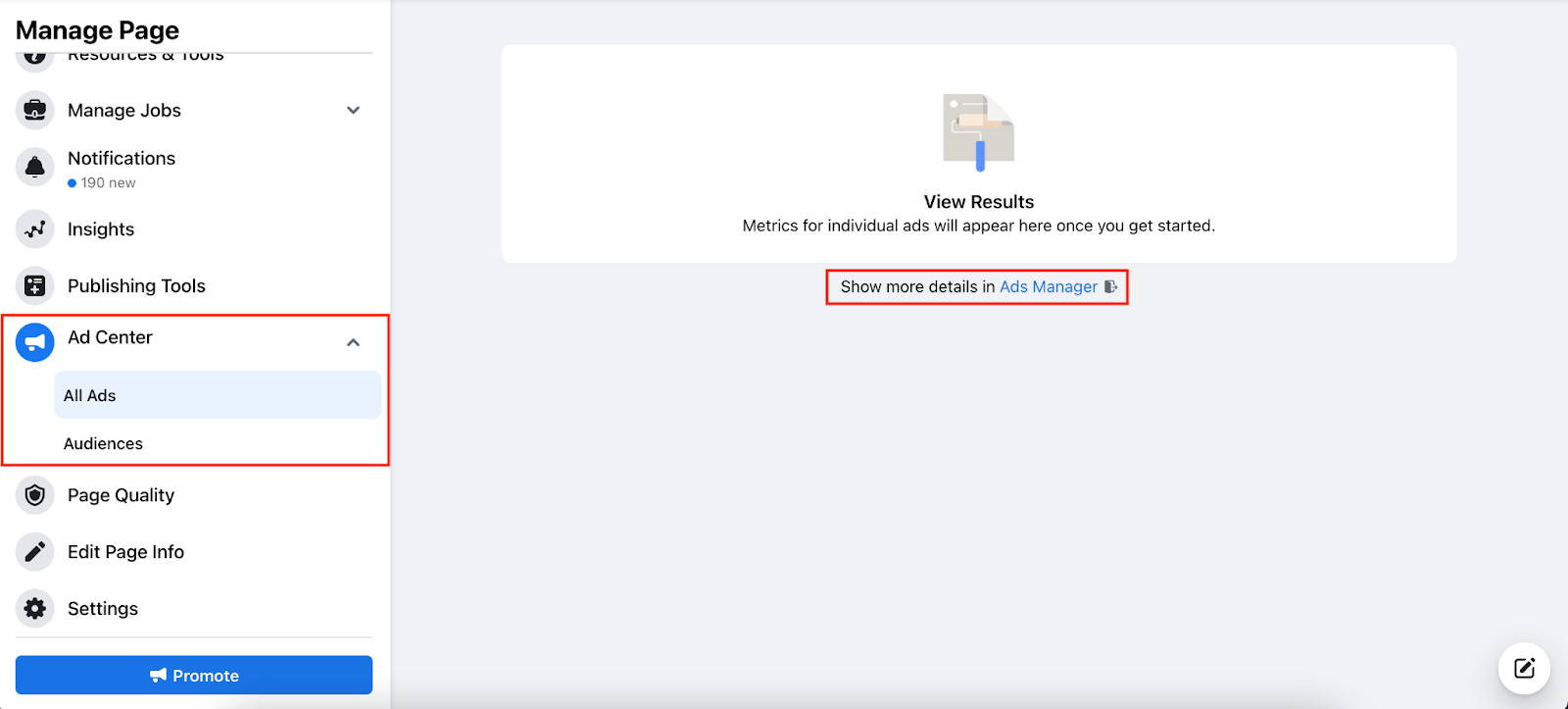
Go to your business’s Facebook page. On the left sidebar, head over to “Ad Center” and choose “All Ads” from the dropdown menu.
At the bottom of the page, click on “Ads Manager.” If you have access to more than one ad account, select the one you want to create an ad for.
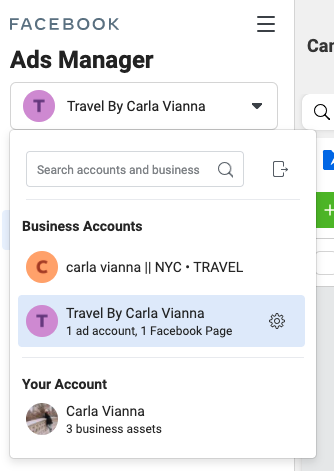
You can also access your Ads Manager via https://www.facebook.com/ads/manager. Here you’ll be taken to an ad account for your personal Facebook page. Use the dropdown menu on the upper left hand side to choose your business’ ad account.
Step 3: Set your objective
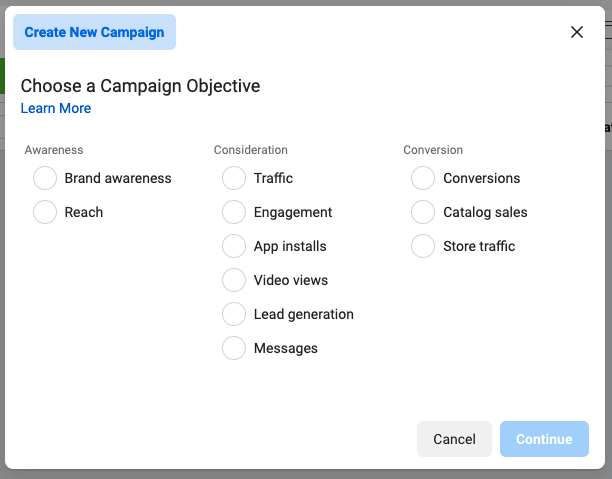
Hit the bright green “Create” button on the lefthand side of the page.
You’ll now be prompted to choose from a variety of different goals for your ad campaign:
- Awareness: brand awareness and reach
- Consideration: website traffic, customer engagement, video vides, and new customer leads
- Conversion: bookings and traffic to your tour description pages
Select the one that best meets the marketing goal you set in step one.
Step 4: Name your campaign, ad set, and ad
Before clicking “continue,” you’ll see the option to name your campaign, ad set, and ad.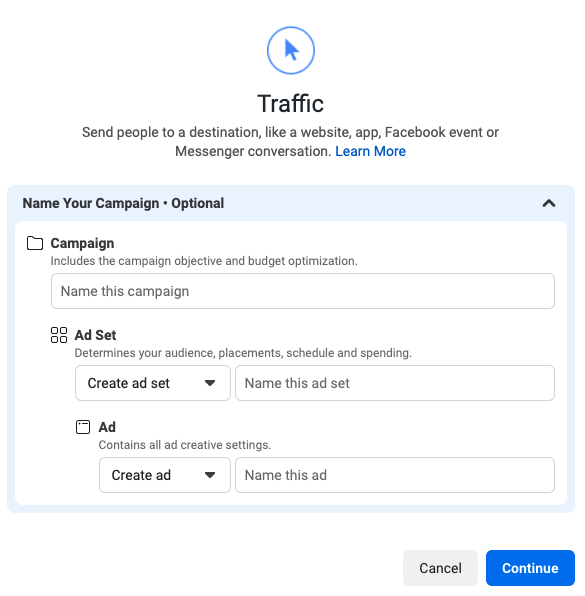
Your campaign includes your ad’s objective and budget optimization.
Your ad set determines your audience, ad placements, schedule, and spending.
Your ad contains all of the creative and visual components for this particular ad.
Step 5: Define your campaign details
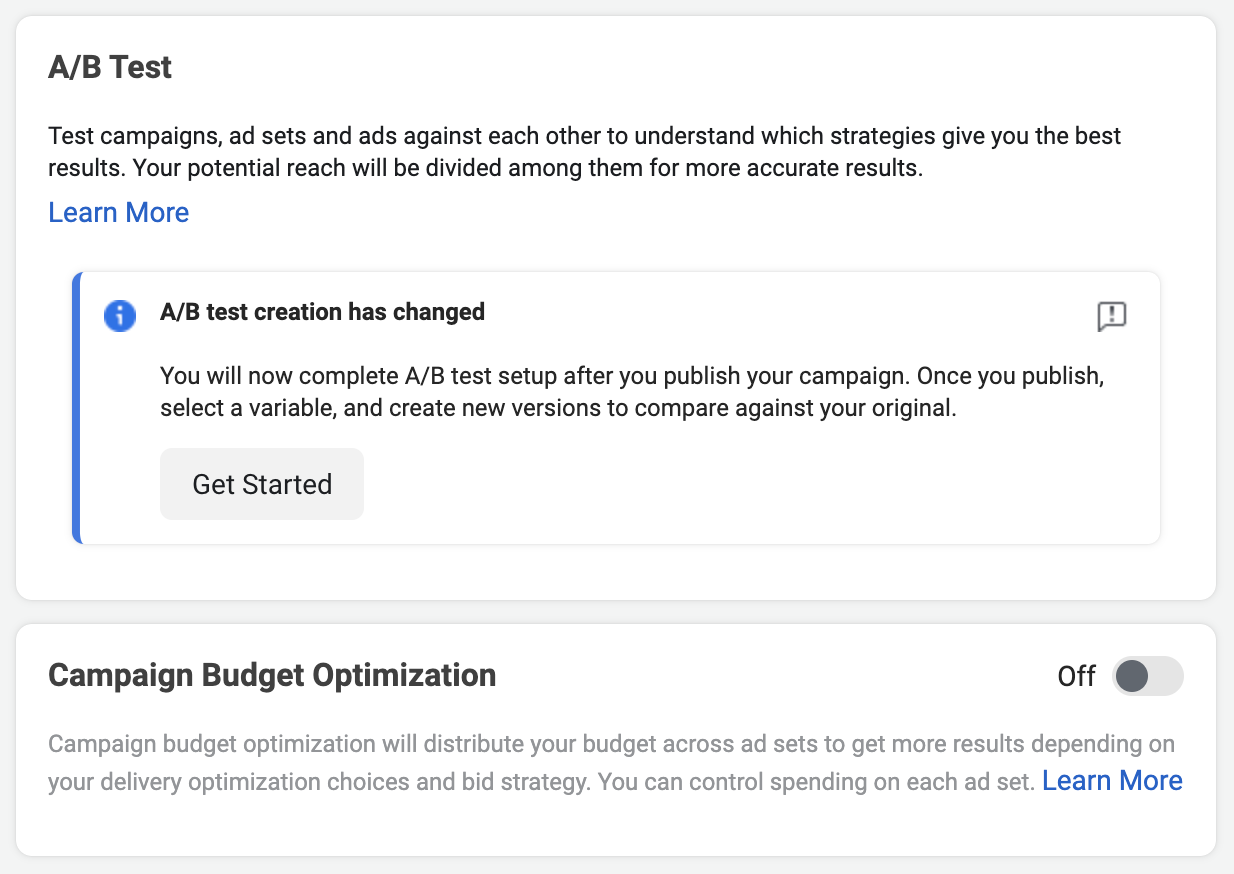
Next, you’ll be taken to a page where you can define all your campaign details. Here you can A/B test your campaign, which means creating two different ads and testing them against each other.
You can also switch on a Facebook ad feature called “Campaign Budget Optimization” to get the most results possible from your campaign, at the lowest cost. You’ll set one overarching campaign budget and Google will automatically fund the ad sets that are performing best.
Step 6: Define your ad set, budget, and target audience
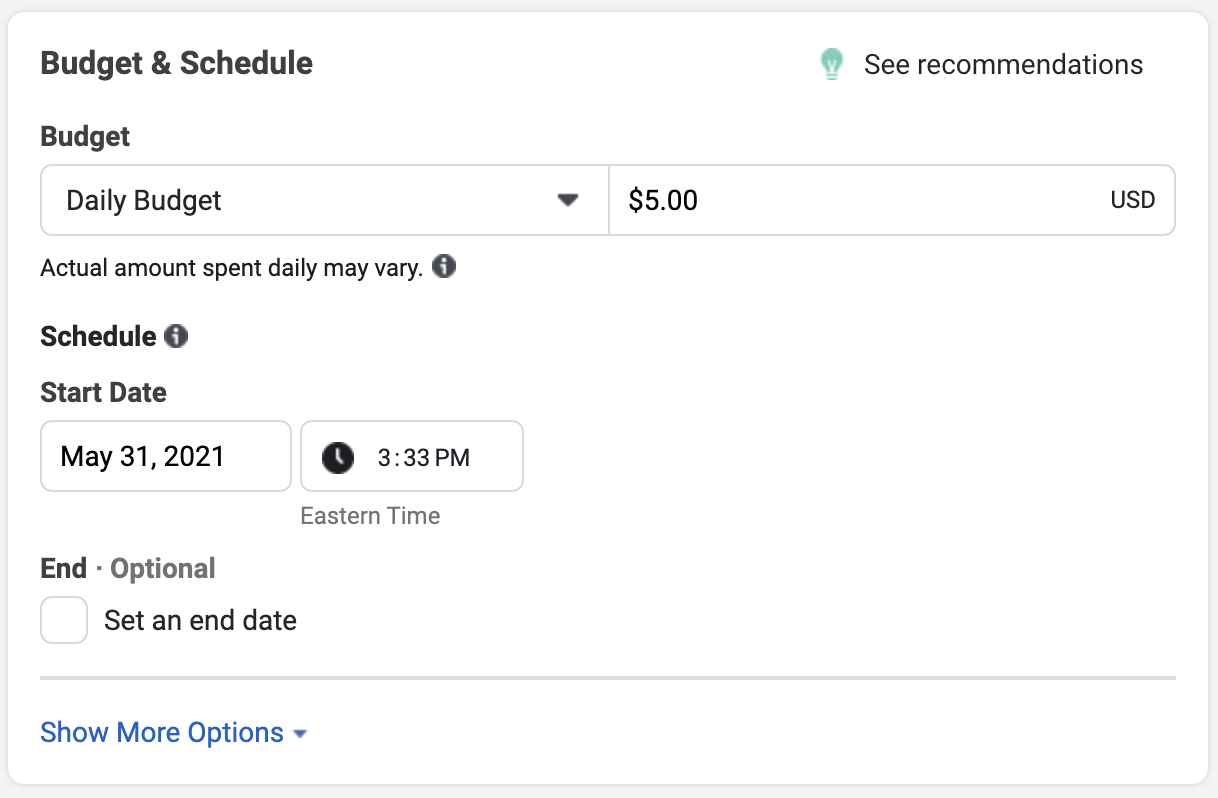
Next, you’ll create your ad set.
You’ll set a budget and schedule for your ad, including a start and end date. You’ll then choose between a “daily budget” — like $5 a day — or a “lifetime budget,” which is the total amount you want to spend on this ad.
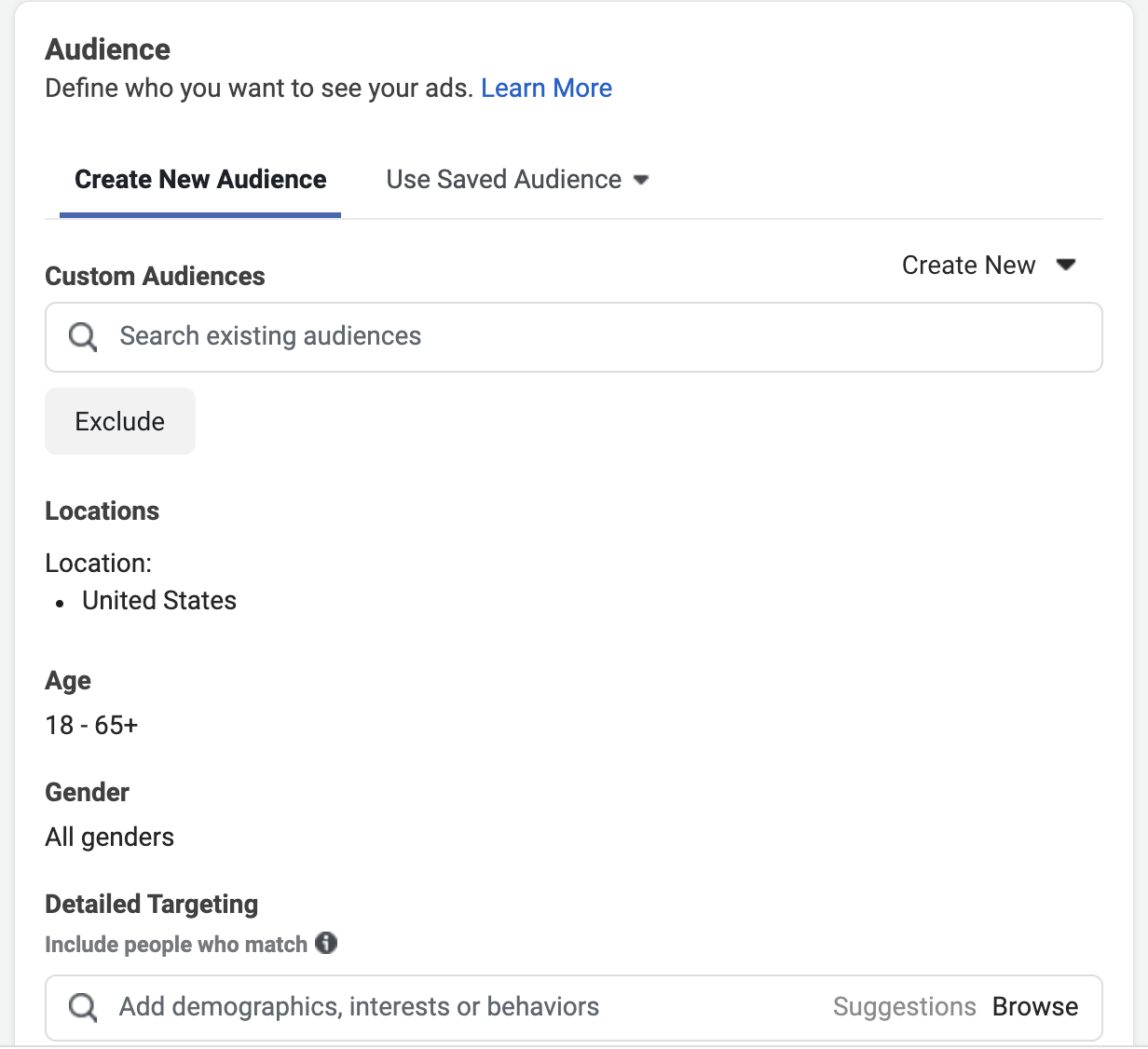
Your ad set also defines your target audience.
You can customize your audience by location, age, and gender, among other demographics. Under “Detailed Targeting,” you can even target specific interests and behaviors like “traveling.”
Under the “Connections” tab, you can include or exclude people who have liked your Facebook page. This will come in handy when setting up a retargeting ad, for example, so that your ad targets people who have already interacted with your page.
Finally, you’ll choose where you want your ad to be displayed. You can leave the ad placement up to Facebook or choose where you want to display it.
Step 7: Create your ad
It’s now time to create your ad. You can use an existing social media post or upload a new image, video, or graphic.
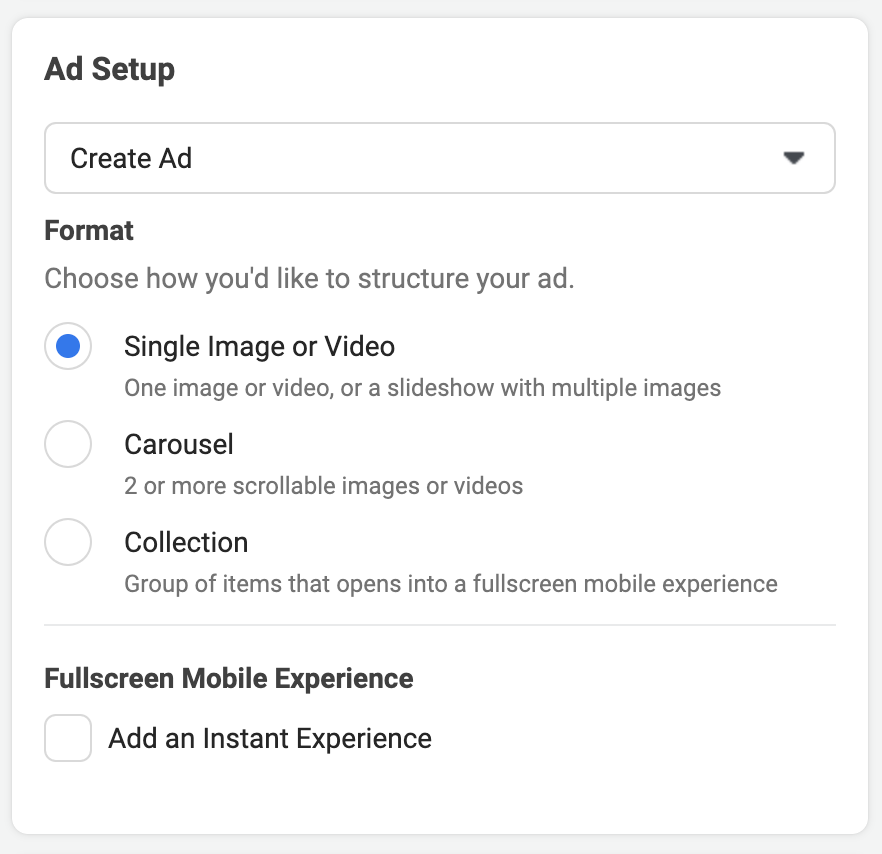
If you create a new one, you can choose from a few different formats:
- Carousel: two or more scrollable images or videos
- Image or Video: One single image or video, or a slideshow with multiple images
- Collection: a group of items that opens into a fullscreen mobile experience
You can add your media and text in the “Ad Creative” section, and choose where you want to direct viewers under “Destination.” Your destination can be your website URL, for example.
You’ll choose the best call-to-action, such as a “Learn More” or “Book Now” button that’ll take users to your desired URL.
Finally, you’ll set up Facebook ad tracking so you can monitor your ad performance.
Step 8: Publish your ad
The final step is to hit “Publish.” Once you submit your ad, Facebook will review it before pushing it live. You’ll get an email from Facebook letting you know your ad was approved.
How do you choose the best audience size + targeting for Facebook ads?
Choosing the right audience is key for a successful Facebook campaign.
You’ll be prompted to determine your audience when creating your ad set, which also defines your ad placements, schedule, and budget.
Facebook allows you to target a very specific audience based on location, age, gender, interests, and behavior. As you narrow down your specifications, you’ll notice that your audience size will change.
Facebook recommends keeping your audience between 1,000 and 50,000 people.
When you narrow down your audience, your ads are more likely to reach more people. Narrowing down your audience to people who are traveling to your location, for example, would increase your ad’s reach because those people are likely to stop and look at your ad.
Reach is an important metric that measures the number of unique people that have viewed your ad.
Your target audience will largely depend on your location and the nature of your tour or activity.
There are several ways to target travelers specifically. When defining your ad set, you can target people who are specifically traveling in your location. You can also narrow down your audience by interests and behaviors — such as “frequent travelers” or people who “like” a particular activity like hiking.
You can also target people who are similar to those who currently like your Facebook page, meaning Facebook will identify users who are likelier to become fans of your business.
What’s the difference between cold and retargeted Facebook ads?
You can approach your ad’s target audience in two ways.
Targeting a cold audience means showing your ad to potential customers that have never heard of your company. You’ll use Facebook’s targeting features to narrow it down based on interests and behaviors.
Retargeting, on the other hand, reaches an audience that’s already familiar with your brand. Your ads would reach people who have already engaged with your business, such as visited your website or liked your Facebook page.
This is a warmer audience that already knows of your business, meaning they’re likelier to make a purchase.
If your company is new, however, you may not have a large enough online audience to retarget. In this case, cold ads would help introduce your brand to more people and establish a larger audience.
How to set up retargeting on Facebook?
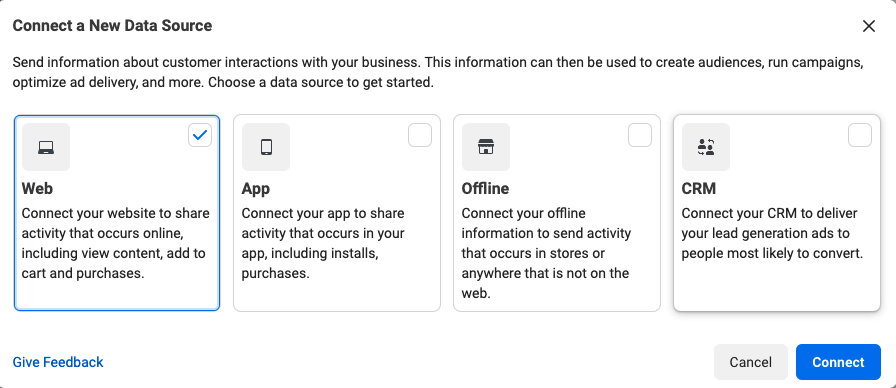
Retargeting ads are shown to people who have already expressed interest or engaged with your company online.
First, you’ll need to install a Facebook pixel on your company website. The Facebook pixel is an analytics tool that gets installed in the code of your website. It helps you track visitor activity and the results of your Facebook ads.
Go to your Events Manager page to create one.
Click on “Connect Data Sources” and choose “Web.”
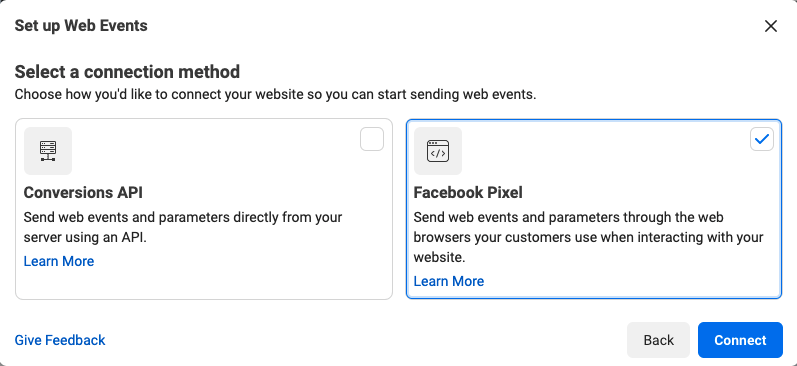
Next, you should choose “Facebook Pixel.”
Once you name your pixel, you’ll add in your website URL for easy setup options. If you can use a partner integration, follow those instructions. For example, if your website is set up on WordPress, you’ll download a plugin that’ll install the pixel for you.
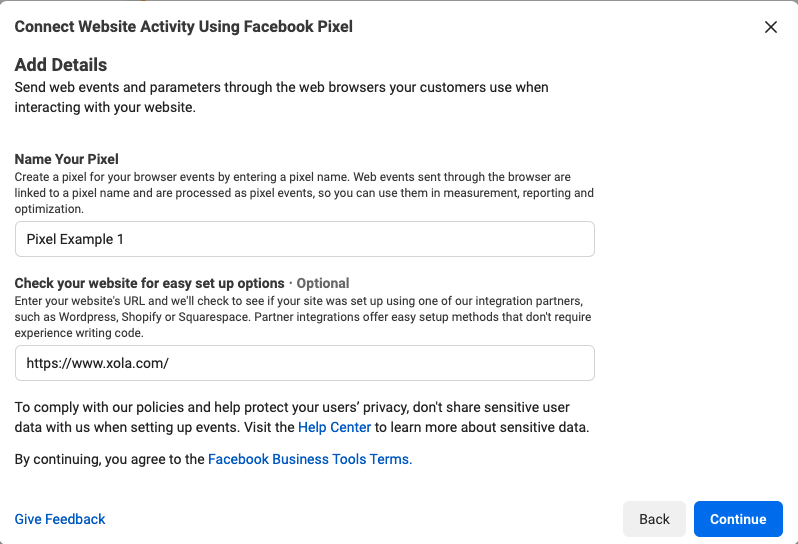
You can also manually add the pixel to your site by copying the pixel base code and pasting it into the header of your website.
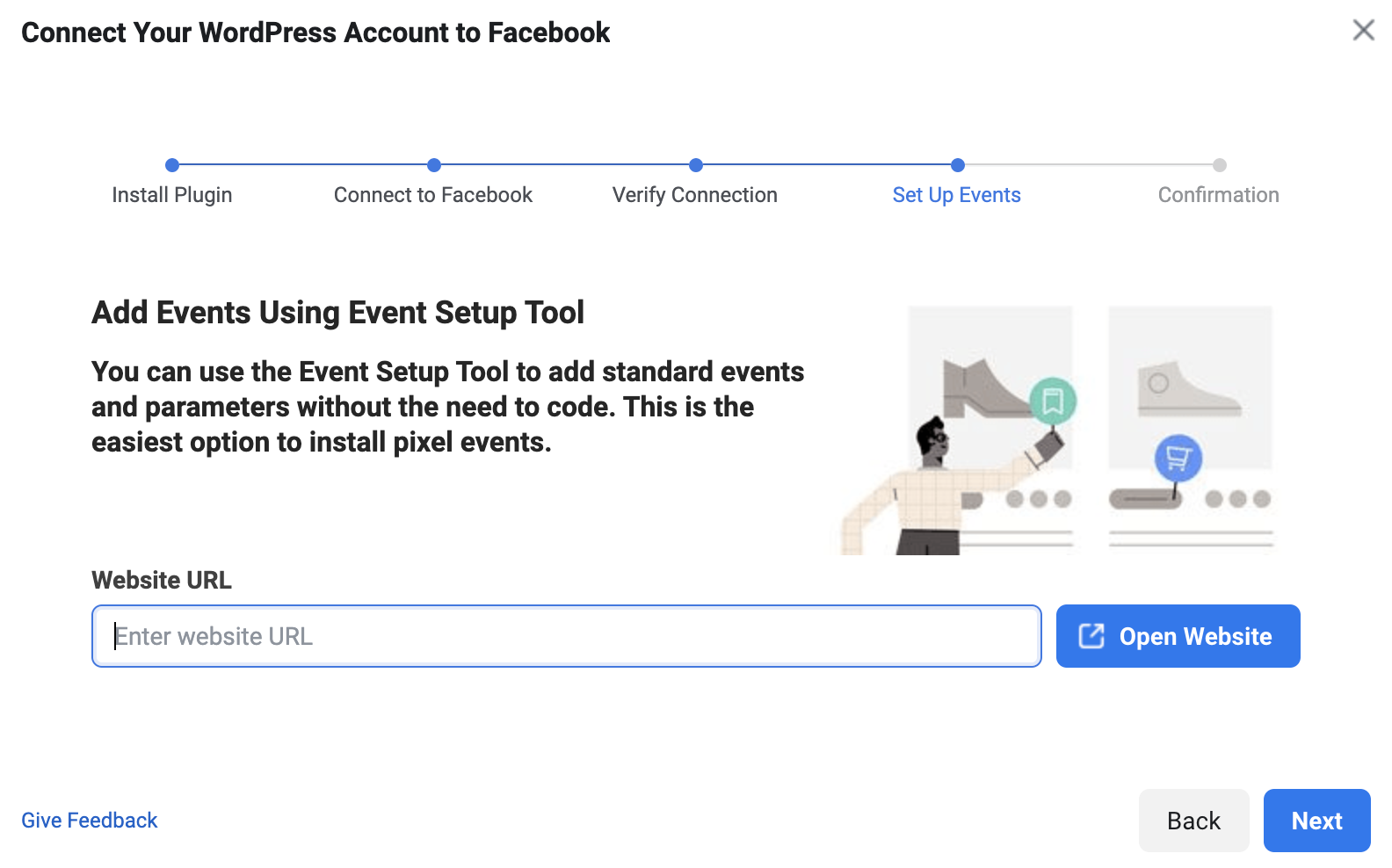
Next, you’ll set up events using Facebook’s events setup tool. Add in your URL and follow the instructions to identify events to track on your page, such as every time someone views a tour page or clicks the “book now” button.
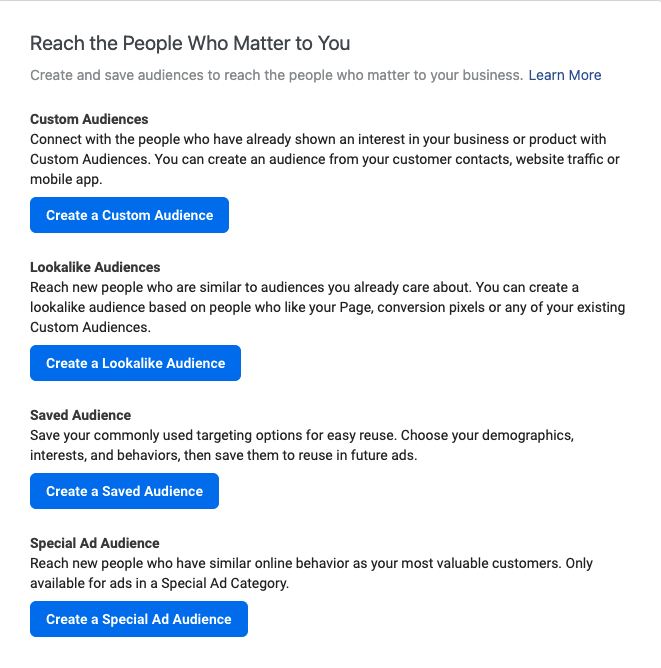
You can also specifically retarget people from your email list. To do this, you’ll make a “Custom Audience” in your Ads Manager.
Open your ad account, go to “Audiences,” then choose “Create Audience > Custom Audience > Customer List.”
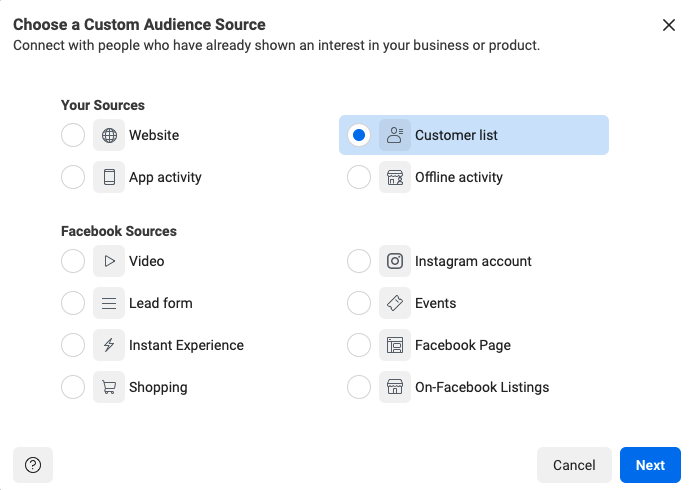
Your customer list will be your email list, which you’ll export from your email marketing software. You’ll upload your email list and select identifiers to include, which in this case will be your customer email, name, and anything else that’ll help Facebook find your contacts.
Facebook will match its users with the information you’re provided, and you can then retarget your email subscribers with ads.
How to create targeted Facebook ads for tours and activities
Before creating a new Facebook campaign, you need to define your objectives. You could use the SMART system to ensure your goals make sense.
SMART goals are Specific, Measurable, Achievable, Relevant, and Time Sensitive. You define exactly what you want to achieve, the metrics you’ll track, and the methods you’ll use to achieve those goals. You should also set a timeline for when you expect to achieve that goal.
Let’s see how escape room, zipline, and axe-throwing operators put this into practice. Here are a few examples from operators using Facebook ads to bring in more exposure and bookings.
Escape Rooms
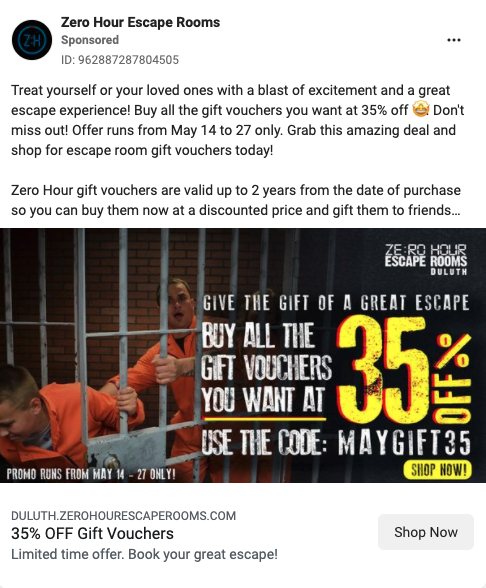
Facebook marketing is an effective way to fill your escape rooms. When setting up your Facebook ads for escape rooms, you’ll want to choose an objective like “Conversions” if you’re trying to drive more bookings. Next, you’ll need to set up your audience.
If you have a limited budget but your website gets more than a few thousand monthly visitors, we recommend starting with retargeting ads. Your ads will be visible to people who have already shown interest in your escape rooms and are therefore likelier to book an experience.
You can retarget your email list and website visitors, for example.
On the other hand, if you have a smaller social media marketing budget and significantly less website traffic, a cold traffic campaign could bring in more results.
Ziplines
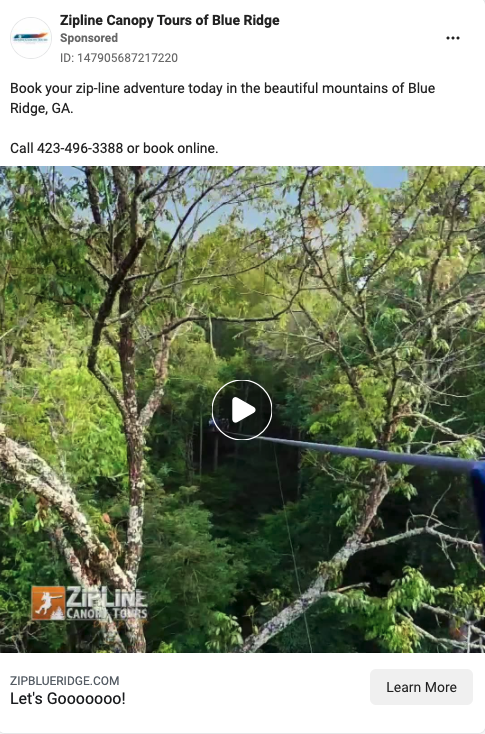
Zipline tour operators can use Facebook ads to target several potential customers.
Your ads can target people traveling in your location by specifying that in Facebook’s advanced targeting options. You could also target people who are similar to your past guests by using Facebook’s Lookalike Audiences, which will automatically build an audience that has similar interests as your past customers.
To create a Lookalike Audience, you need to create a list of past customers on Facebook. You can do this by uploading a list of customer names and emails, or if you use a zip line booking software like Xola, you can create lists automatically using Facebook’s tracking pixel.
Axe Throwing
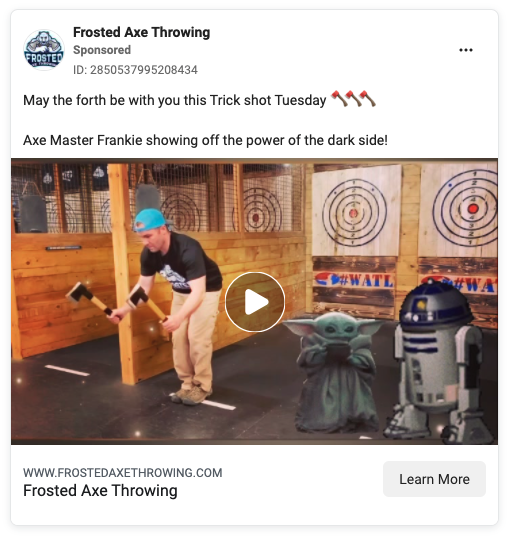
Axe throwing operators should start with Facebook retargeting ads to reach people who have visited your website but not made a booking. Follow the steps outlined above to install your Facebook pixel to do so.
You should also target your email list to convert one-time customers into repeat guests.
Your ads should always have a strong visual component to catch viewers’ attention, such as highlighting photos and videos of your customers shown in the example above.
Outdoor Adventure Tours and Activities
You don’t want to appeal to any traveler, but rather outdoor adventure travelers specifically.
You should use Facebook’s advanced targeting features to create an audience interested in general topics like “nature,” or more specific activities like “hiking,” for example.
In the Royal Gorge tour operator’s case, the ad is likely targeting people interested in rafting and ziplining. You could also create a Lookalike Audience where Facebook will target viewers who are similar to your current customers.
How much should I spend on Facebook ads?
A typical marketing budget for any business is 5% to 12% of revenue. New companies might spend a bit more since they’re still trying to get their name out there and establish brand awareness.
That being said, there’s no magic number for how much you should spend on Facebook ads for tours. Ultimately it’ll depend on your goals and business revenue.
Consider that the Facebook ad cost for most industries is somewhere between $0.50 and $2.00 per click. For travel specifically, it’s about $0.63.
Knowing this, you can create a budget by defining your goals and determining how many leads you’ll need, what your cost per core event will be, and how much you can afford to spend to make a booking.
Once you settle on an overall Facebook budget, it should be distributed into three categories:
- 20% for audience building
- 20% for retargeting your audience
- 60% for promotional offers
When building your ad, you’ll be prompted to set a daily budget (how much you’re willing to spend on a campaign each day) or a lifetime budget (how much you’re willing to spend throughout the entire campaign).
The minimum ad spend on Facebook is $1 per day, and the more you spend, the more people will see your ad.
AdEspresso recommends starting with a small ad spend across a few days to see how well different ad sets perform. After five days or so you should have an idea of which ads are working for you. Then you can ramp up your budget for those ads specifically. Hootsuite explains exactly how it would spend $100 on Facebook ads if you’re working with a small budget.
Facebook Ad campaign examples
Whether you’re experimenting with video ads or carousel posts, there are a few components you simply can’t skip: Your ads should highlight what makes your tours or activities unique, target the right audience, and have a clear call to action horse-drawn.
Let’s see how tour and activity operators put this into action. Here are some creative examples of Facebook and Instagram ads to inspire you.
Launch a new location
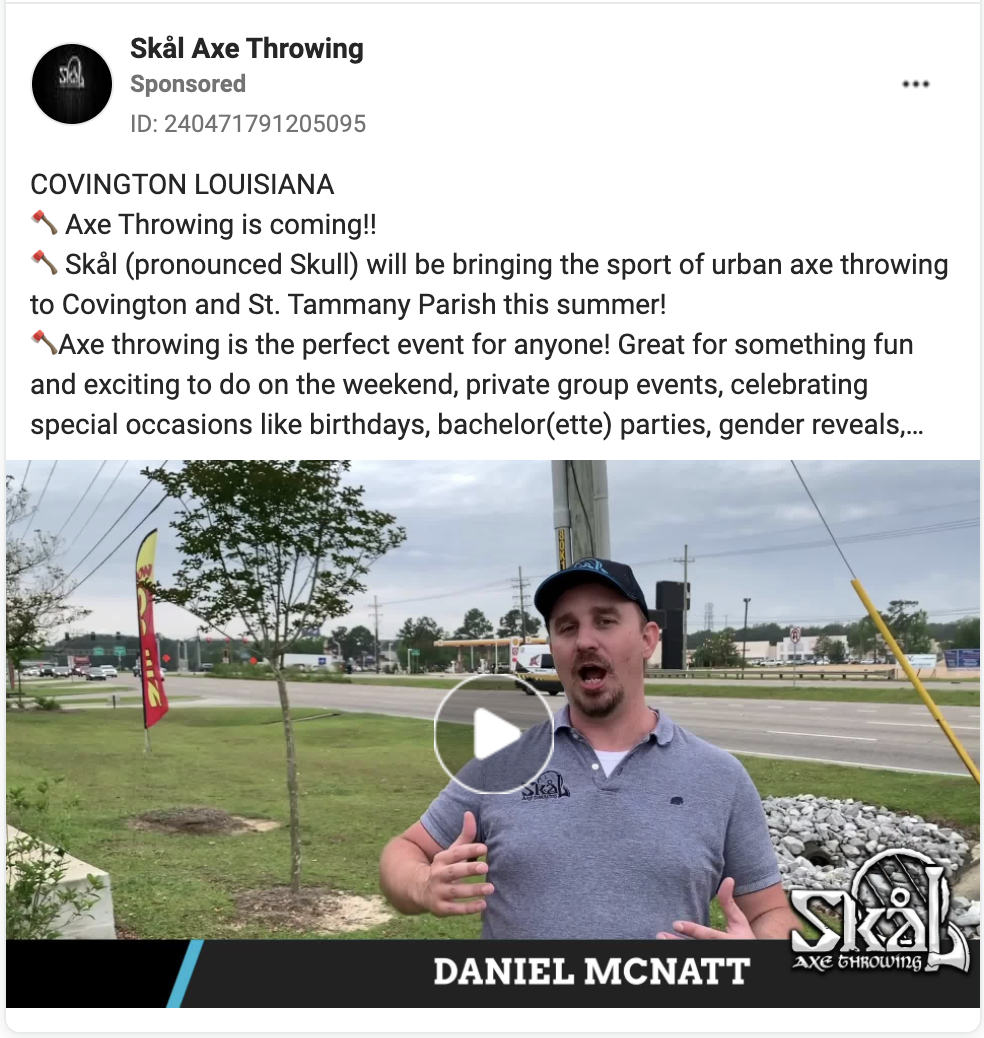
Mississippi-based Skål Axe Throwing uses Facebook ads to announce its expansion to a new state. In this particular case, the activity operator uses a personalized video ad to introduce his company to a new audience in Louisiana.
Skål is likely using Facebook’s targeting features to reach an audience located in Covington, where the company will open its new axe-throwing attraction.
Video can drive more engagement than standalone images, especially when featuring members of your company. Featuring owner Daniel McNatt himself announcing the opening is an effective way to connect with a new audience. Potential new customers will put a face to the company and become familiar with the people behind the grand opening.
Promote a new tour or experience
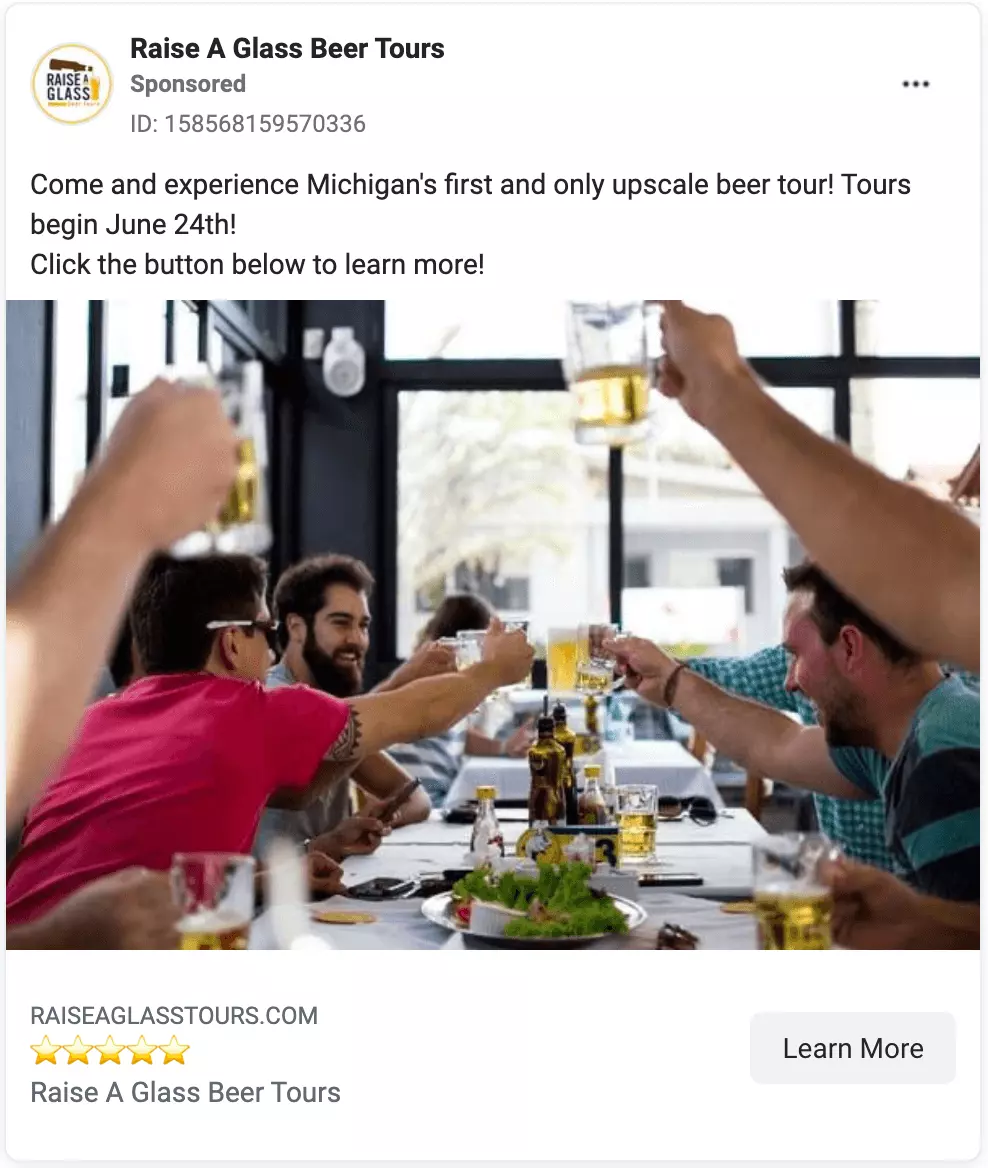
Raise a Glass Tours, a Michigan-based tour operator offering wine and beer experiences, also uses a Facebook ad to announce a business update.
In this case, Raise a Glass is promoting the beginning of a new tour in Michigan. What does Raise a Glass do well in this ad?
Aside from featuring a great visual, the ad particularly highlights what’s most unique about the experience: the first and only upscale beer tour. The tour operator aims to appeal to an audience looking for an elevated beer experience that’s differentiated from others. This is where knowing your audience comes in handy.
Share a behind-the-scenes perspective
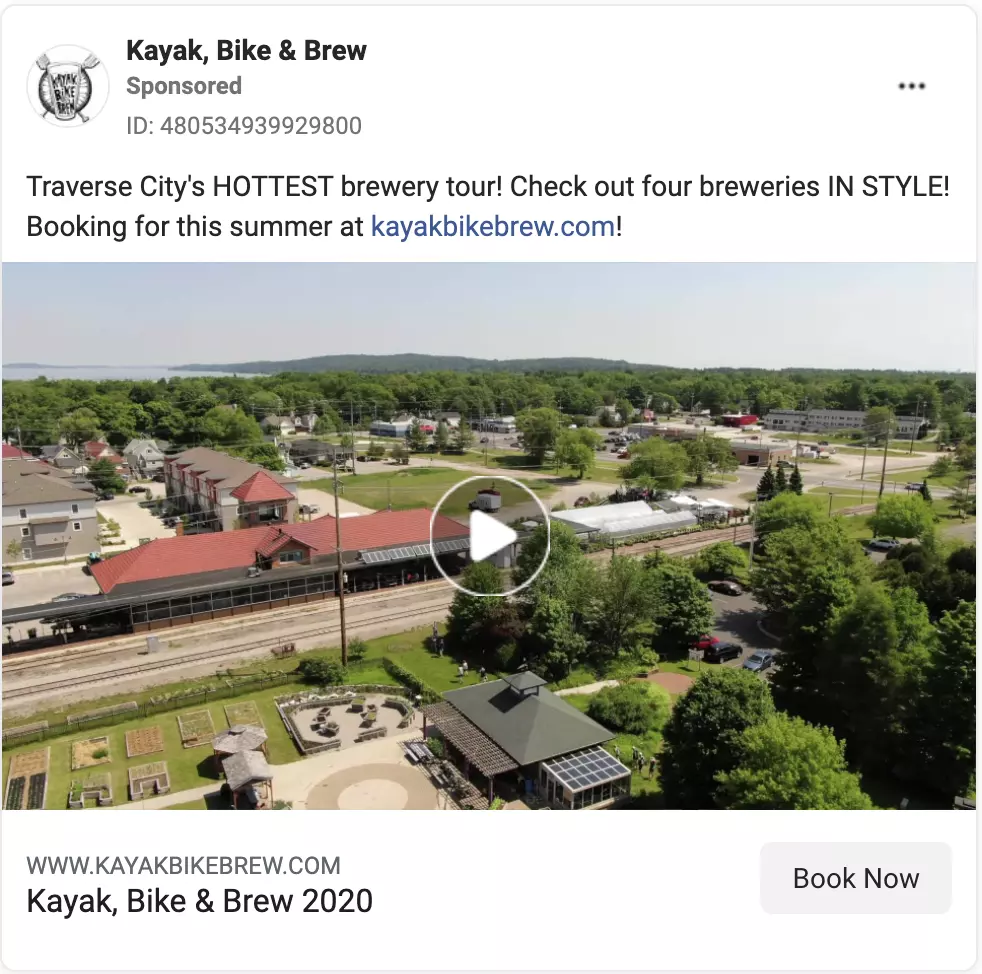
Kayak, Bike & Brew runs a unique brewery tour that features kayaking and biking in Traverse City, Michigan.
Their Facebook ad does a phenomenal job explaining how the tour works and what guests can expect. A company employee narrates the video, which goes over each stop guests can expect on the tour.
The video follows actual guests having a great time on tour, which already has a positive effect on the viewer. It’s then edited in a fun way with a lot of quirky transitions. The ad does a wonderful job conveying the overall fun and playfulness of the tour — and the company behind it.
Promote any awards you’ve won
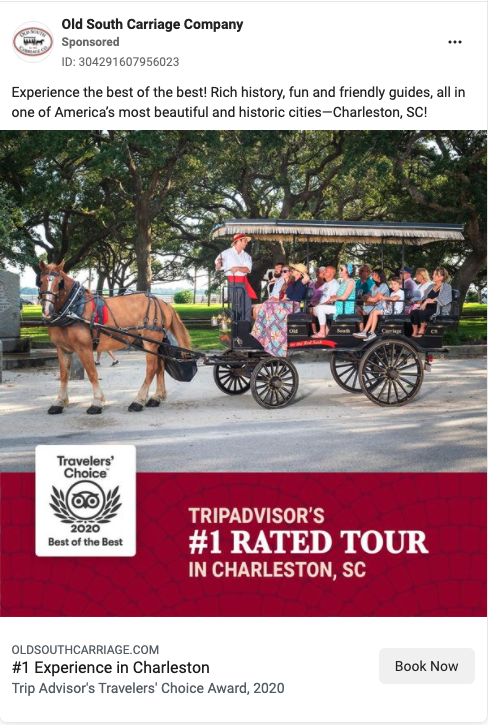
Have you recently won an award? Are you the top-rated tour in your region? Charleston-based tour operator Old South Carriage used its high rating on TripAdvisor as a hook in a recent ad for its horsedrawn carriages.
The tour operator created a graphic that aligned with its brand colors to advertise this achievement. Reviews can have a big impact on bookings. A recent TripAdvisor survey found that 72% of the respondents read reviews before deciding on things to do.
Highlighting positive reviews, awards, or rankings in your Facebook ads is a smart way to hook potential customers in.
Advertise to locals
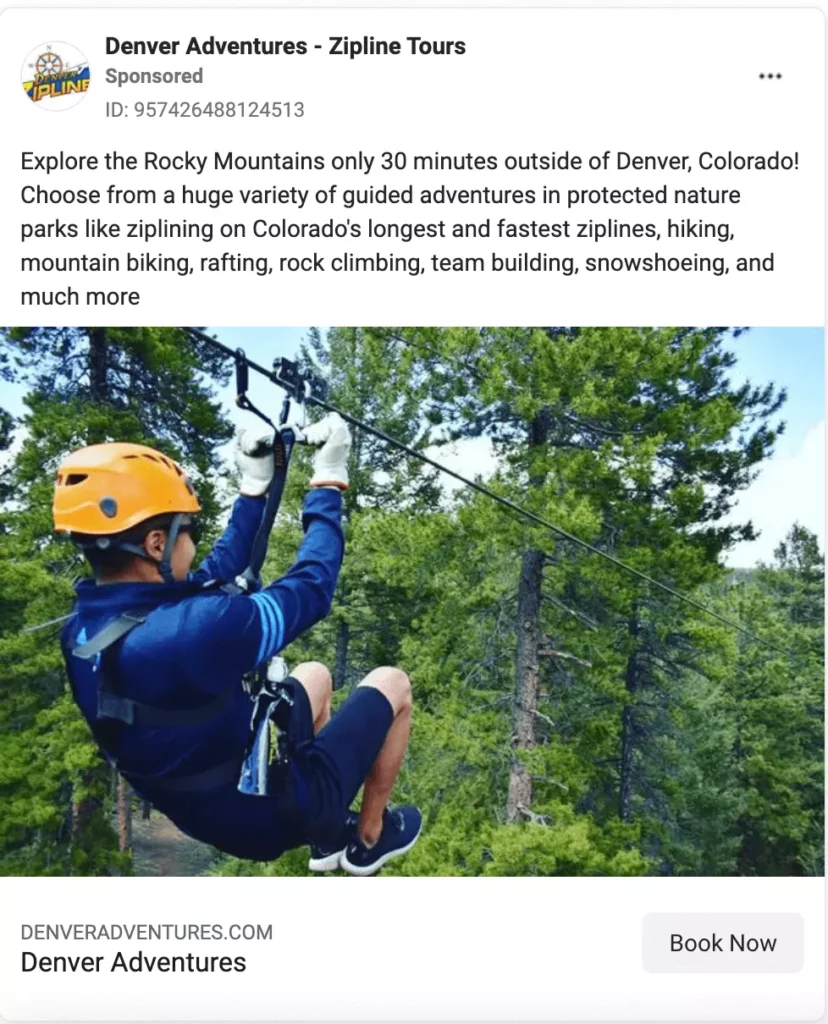
Colorado-based zipline operator Denver Adventures uses the ad above to persuade people visiting the city of Denver to explore the outdoors.
The activity operator points out that visitors can reach the Rocky Mountains in just 30 minutes on a variety of guided tours — for someone who’s never visited, this takes the hassle out of figuring out how to explore the park alone.
Denver Adventures also uses images of outdoor adventures to directly appeal to that audience.
Split-test your ad copy and creatives
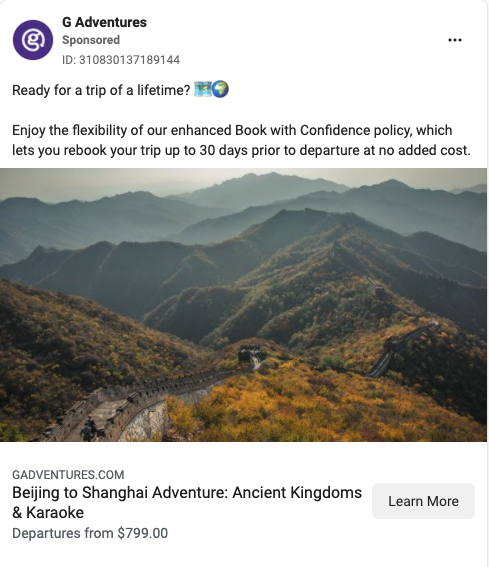
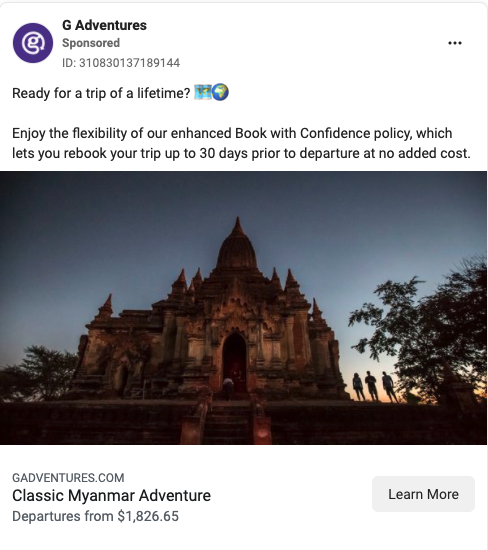
Tour operator G Adventures creates several different ads within one format by switching up the images and calls-to-action, as shown in the examples above. This is a smart way to see what destinations are appealing most to your audience.
After running both of the above ads for a week or so, G Adventures will know what destination is garnering the most clicks and conversions. Tour and activity operators can try this with their different experiences to get a feel for what’s more in demand in your region.
Now that you’ve had a look at some creative examples of Facebook ads, it’s time to start working on your own.
Remember that all ads should highlight what’s unique about your tour, target a specific audience, and have a clear call-to-action.
You should experiment with video, carousel, graphics, and single image ads to see what resonates with your audience the most. It might take some trial and error, but by starting today, you’re one step closer to acing your Facebook marketing.
In addition, Facebook’s targeting features allows tour operators to promote their tours to the people who are most likely to book them — including people traveling in your location or past website visitors.
If you haven’t started advertising on Facebook or Instagram yet, now is the time to do so. Use this guide to set up your first Facebook travel ad.
